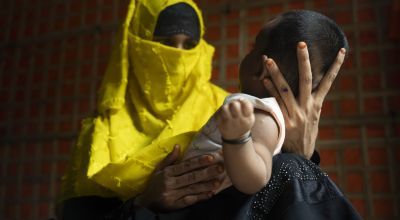
Read our 2023 annual report

Knowledge Hub
The Rohingya Crisis explained: Five things to know, seven years on
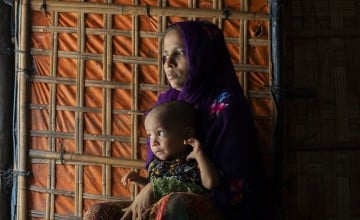
Here’s what you need to know about the Rohingya Crisis in 2024.
On August 25, 2017, an outbreak of violence in Myanmar’s Rakhine State forced hundreds of thousands of Rohingya people to flee their homes. Seven years later, over 1 million stateless Rohingya remain in temporary shelters away from home. More than 980,000 of them have spent the last seven years on a narrow strip of hilly land below the city of Cox’s Bazar, Bangladesh.
This isn’t an anniversary to celebrate, especially as the plight of the Rohingya — despite being one of the largest refugee crises today — has remained largely absent from headlines since the initial attacks in 2017. Here are five things you need to know about the Rohingya Crisis in 2024.
1. This isn’t an isolated crisis for the Rohingya

The Rohingya are a predominantly Muslim ethnic minority group who are indigenous to Southeast Asia. As of early 2017, roughly 2 million lived in the Rakhine State of Myanmar (formerly known as Burma, and a Buddhist-majority nation), many for generations. Despite their long standing relationship to the land, they have historically not been recognised by the government and denied citizenship, leaving them the world’s largest stateless population.
Without recognition as citizens or permanent residents, the Rohingya had limited access to education, jobs, healthcare, and social safety nets, resulting in chronic poverty and marginalisation. The United Nations has referred to the Rohingya as “one of the world’s most persecuted minorities,” and they have faced targeted violence in Myanmar over the last several decades, including events in 1978, 1991-92, and 2016.
However, an escalation in violence that began in August 2017 was the starting point for the latest — and largest — crisis.
2. The displacement of Rohingya 2017 was the largest mass exodus in Asia since the Vietnam War
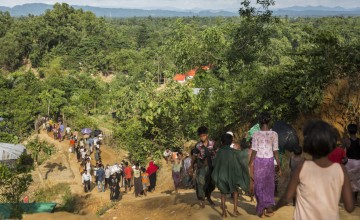
While we place the beginning of the current Rohingya Crisis on August 25, 2017, violence had been a fact of life for many throughout the year after an especially tense 2016: According to the UN’s High Commissioner of Refugees (UNHCR), between October 2016 and February 2017, over 70,000 Rohingya had fled Myanmar for neighbouring Bangladesh.
However, matters escalated sharply in the early hours of August 25 with violent clashes that led to a widespread military crackdown in Rakhine State. That same day, hundreds of thousands of Rohingya began making their way to the Bangladeshi border — a distance of roughly 225 kilometres that many made on foot across the jungle or as a dangerous sea voyage across the Bay of Bengal. Within the first three weeks, over half a million Rohingya had made it to Bangladesh amid entire villages being burned to the ground and thousands of people killed in Rakhine State. (A 2023 statement from the UN estimates the totals were 300 villages and 10,000 men, women, and children.)
Approximately 700,000 Rohingya entered Bangladesh, which had already been a host community to approximately 300,000 Rohingya before August 25. Additionally, 90,000 fled to Thailand, and 20,000 to India. The weeks following August 25, 2017 led to the Rohingya population in Myanmar reduced by roughly half.
3. The situation for Rohingya refugees in Bangladesh has only got more difficult
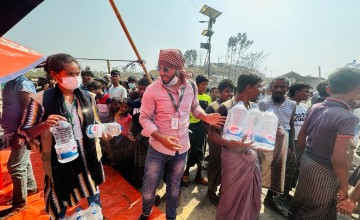
The crisis has developed into a protracted emergency for Rohingya in Bangladesh. Most of the camps that were set up for incoming Rohingya in Cox’s Bazar were built on uneven, sandy hills that were rapidly cleared in response to 2017’s mass displacement. They eventually formed 33 camps, making Cox’s Bazar the world’s largest refugee settlement.
Since then, these informal shelters have faced the constant threats of the elements, including flooding and landslides, which are especially common during monsoon season in Bangladesh (which takes place from July to October). All shelters must be built from bamboo and tarps — no concrete or bricks — meaning that they collapse easily in extreme weather. The effects of climate change in Bangladesh, including this summer’s unprecedented floods, have also not spared camp residents in Cox’s Bazar.
The cramped conditions of the camp also leave these structures vulnerable to fires. Between January 2021 and December 2022 alone, there were over 220 fires in the camps. A recent blaze in January, dubbed by the Australian Broadcasting Corporation “the fire the world ignored,” destroyed 800 homes and left over 7,000 Rohingya homeless. Many Rohingya have lost their homes multiple times over in the last seven years.
4. 95% of Rohingya families in Bangladesh depend on humanitarian aid
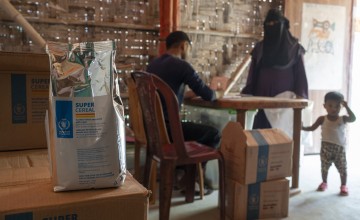
That ABC headline captures one of the toughest realities for the 1 million (and then some) Rohingya who have been living in these informal settings over the last seven years. Life in these refugee camps continues, with babies being born, families needing to eat, and children going to school. However, after initial headlines, the Rohingya barely factor into international news coverage (save for a few pieces every August on the anniversary of this latest crisis).
This translates into funding: The $852.4 million (USD) required to fund this year’s humanitarian response plan in Cox’s Bazar is just 33% funded, leaving thousands of people in need of essential services — including nutrition support, other forms of healthcare, clean water, sanitation infrastructure, and social protection — unable to have their needs met by a group of international and local NGOs otherwise poised to deliver. In recent years, malnutrition rates among the residents of the camps have gone up, with the IRC estimating that hunger has increased by 60% between 2022 and 2023. This corresponded with cuts to food rations made in 2023 following a severe funding shortage — an impossible decision made on the part of the UN that reduced monthly allowances from $12 USD per month to $8 USD.
Children under the age of five are especially vulnerable to these cuts, with malnutrition leaving their developing immune systems more compromised and open to viruses like diarrhoea and cholera that, given the circumstances, can be fatal.
5. Host communities in Bangladesh are struggling and looking for solutions to a crisis with no clear resolution
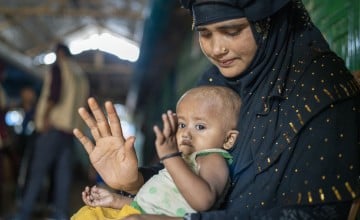
Often underreported in coverage of any refugee crisis are the host community’s efforts to maintain their own dignity, stability, and health in such difficult circumstances. The area surrounding Cox’s Bazar has historically been a low-income area of Bangladesh. Concern’s former Country Director for the area, A.K.M. Musha, pointed out that local lives have changed significantly since this massive population flow.
“There is huge socio-economic and environmental pressure resulting in increased tension between refugees and the host community,” he said. “The tensions will continue to increase unless the host communities are supported well. It's a difficult situation for all.”
While the Bangladeshi government has gone to great lengths to accommodate the influx, the impact is being felt as local resources go into the relief effort. Prices of goods and services are driven up, and labour becomes cheaper — lowering incomes. One solution that the government put into effect was relocating a proposed 100,000 Rohingya refugees in Cox’s Bazar to the island of Bhasan Char (which, like much of Bangladesh, is especially vulnerable to rising sea levels) in the Bay of Bengal. While 27,000 Rohingya moved to the island with the promise of more aid, a lack of funding has meant that these relocated Rohingya suffer both a lack of supplies and a greater sense of isolation.
The Rohingya Crisis: Concern's response
Concern is one of over 100 NGOs — both local and international — responding to the influx of Rohingya refugees in Bangladesh. We were one of the first organisations to respond, owing to our presence in Bangladesh for over 50 years.
In the last seven years, we’ve reached hundreds of thousands of Rohingya refugees — and vulnerable members of the host community — with both frontline and ongoing support, including protection, livelihood, nutrition, and healthcare services. In the camps, Concern provides the best quality comprehensive acute malnutrition treatment and prevention to ensure lifesaving nutrition support for children under five, along with pregnant and lactating women. In the host community, our priority is to reduce poverty and build resilient communities, by supporting livelihood activities working with the Government of Bangladesh.
Last year, we reached over 126,000 people in Cox’s Bazar. Over 90,000 were enrolled in our integrated nutrition programme, which provides life-saving support to Rohingya families via eleven nutrition centres across seven of the camps.


